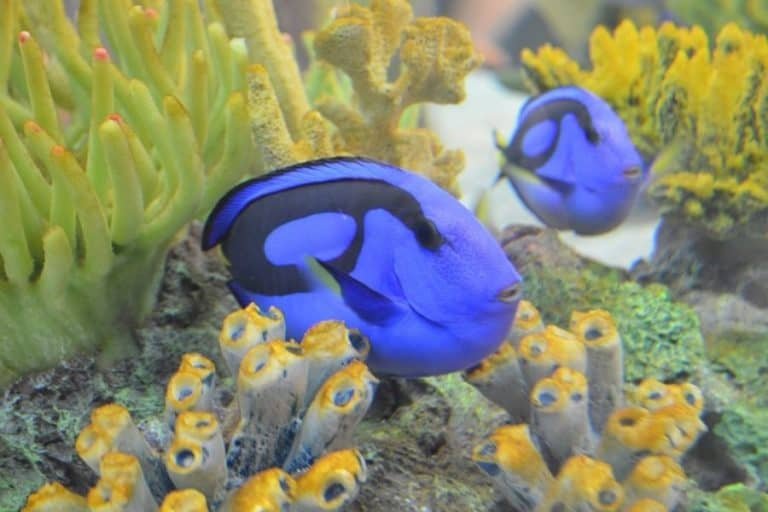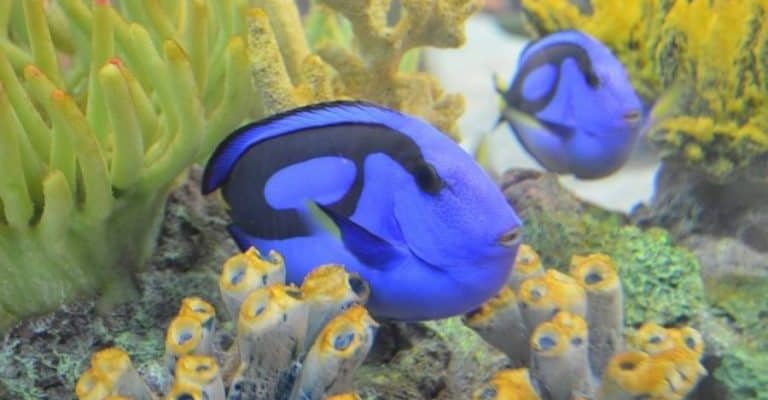
Blue Tangs, or Paracanthurus hepatus, are native to the warm waters of the Pacific and Indian Oceans. They’re known for their vibrant blue bodies and bright yellow tails, which makes them a popular choice among aquarium enthusiasts. But there’s so much more to these fish than their striking appearance! Let’s explore their behavior and temperament, and uncover what makes them tick—or swim, in this case.
Social Structure of Blue Tangs
Blue Tangs are fascinating for their social behavior. They’re mostly seen swimming in pairs or small groups, which allows them to interact and establish social hierarchies. They often form schools to protect themselves from predators. It’s similar to how you might stick with friends in a crowded place; there’s safety in numbers, right?
Within these schools, you might notice that some Blue Tangs are more dominant while others play a submissive role. This dynamic helps them maintain order and reduce conflicts. The dominant fish are usually larger and impose their authority over the smaller ones. It’s nature’s way of ensuring everyone knows their place, much like a team where each member has specific roles to work together.
Interestingly, while Blue Tangs are cooperative, they can also be quite territorial, especially when it comes to their nesting areas. They will defend their space vigorously against intruders, using their sharp spines as a warning. Think of it as a homeowner who’s protective of their yard; they’ll do what it takes to keep unwelcome guests away!
Feeding Behavior
Blue Tangs are herbivores, which means their diet mainly consists of algae and plant matter. This dietary preference plays a huge role in their behavior. They spend a significant part of their day grazing on algae-covered rocks. Imagine them as little lawnmowers of the ocean, keeping the reefs clean!
Their feeding behavior is also quite social. Often, you’ll see them grazing together, a behavior known as “cleaning station.” In nature, certain fish will come to these cleaning stations, where Blue Tangs, along with other species, will pick parasites off them. You might be wondering why they do this—well, it’s a two-way street! The Blue Tang gets a meal, while the other fish get a nice clean-up. It’s like a spa day for fish!
Additionally, their feeding habits can sometimes lead to squabbles between Tangs, especially if food is scarce. They’ll chase each other around, showing off their bright colors in an attempt to assert dominance over feeding spots. Think of it as a friendly competition to see who gets the best bites!
Activity Levels and Energy
One thing that stands out about Blue Tangs is their energy. They’re active swimmers and love to explore their surroundings. You’ll often see them darting in and out of rock formations in a reef. This behavior is not just for fun; it helps them find food and avoid predators.
During the day, they are most active, darting around the reef in search of food or potential mates. At night, however, they settle down and become less active, hiding among the coral to rest. If you’ve ever felt the need to recharge after a busy day, these fish do something similar. They find comfort in secure spaces where they feel safe from threats.
Their energetic personality can also be a bit of a challenge in an aquarium setting. If they don’t have enough space to swim and play, they might become stressed or display aggressive behaviors. Imagine being cooped up in a small room for too long; you’d feel restless, wouldn’t you? To keep them happy, it’s essential to provide adequate space and stimulation!
Temperament: Friendly or Feisty?
When it comes to temperament, Blue Tangs have a bit of a reputation. Generally, they are considered semi-aggressive, especially when it comes to their territory or food. They can be friendly with other species but might show aggression toward their own kind if not given enough room.
In a community tank, it’s best to pair them with similarly-sized fish or those that are not territorial. For example, pairing a Blue Tang with smaller, non-aggressive fish can lead to a harmonious environment. It’s a bit like ensuring everyone in a group has a similar vibe; conflicts are less likely when there are no strong personalities clashing.
New additions to a tank can also trigger their feisty side, especially if they feel their territory is being invaded. It’s important to introduce new fish carefully, allowing time for them to acclimatize. Think of it as easing into a new social group; you wouldn’t want to dive headfirst into a party without making some introductions first!
Breeding and Reproductive Behavior
Breeding Blue Tangs can be quite a challenge, as they rarely breed in captivity. However, in the wild, their reproductive behavior is unique and fascinating. They often engage in spawning, where males and females come together in a synchronized dance. This behavior can look like a colorful ballet, with the fish swimming up and down in the water column.
During the spawning process, males will display their best colors to attract females. The brighter the color, the more appealing they are! Once a female selects a mate, they release their eggs and sperm into the water, where fertilization occurs. It’s a brief but beautiful moment in their life cycle.
Interestingly, Blue Tangs don’t provide parental care for their young. The eggs hatch in about 24 to 48 hours, and the tiny larvae are left to fend for themselves. It’s a harsh world out there, and their survival depends on their ability to hide and seek food. This reminds us of the importance of independence, doesn’t it? Sometimes, we have to learn to swim on our own!
Challenges and Care in Captivity
Keeping Blue Tangs in captivity can come with its own set of challenges. Their active nature means they require a significant amount of space—ideally, at least 70 gallons of water. This is to ensure they have room to thrive, explore, and express their natural behaviors.
Water quality is crucial for their health. Blue Tangs are sensitive to changes in salinity and temperature, so maintaining a stable environment is key. Regular water changes and monitoring parameters will help ensure they stay happy and healthy. Picture it like maintaining a cozy home; you wouldn’t want to live in a place that isn’t clean or comfortable.
Feeding them a varied diet is also essential. While they love algae, it’s important to supplement their diet with high-quality marine flakes or frozen foods rich in vitamins. Striking the right balance in their diet can prevent common health issues, such as ich, which can easily spread in aquarium settings.
In conclusion, Blue Tangs are not just beautiful fish; they also have rich behavioral and temperamental traits that make them captivating companions. Whether in the wild or an aquarium, their social structures, feeding habits, and dynamic personalities add depth to their character. With the right care, Blue Tangs can bring a splash of color and life to any aquatic setting!

